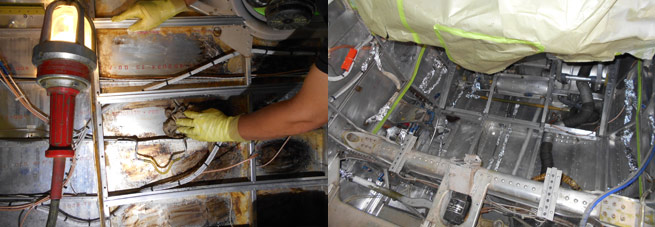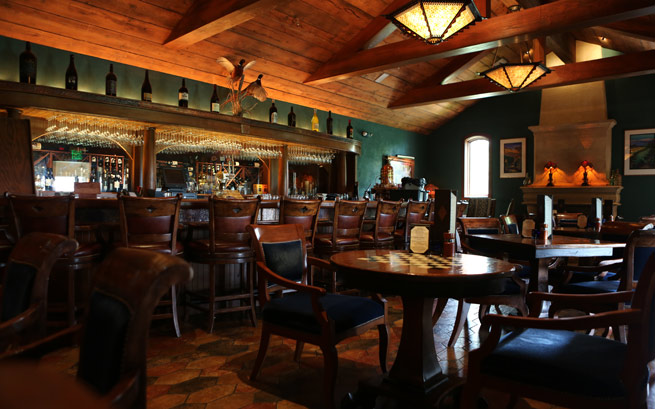Pilot Briefing: Tuskegee Airman mentors a young pilot
Flying with history
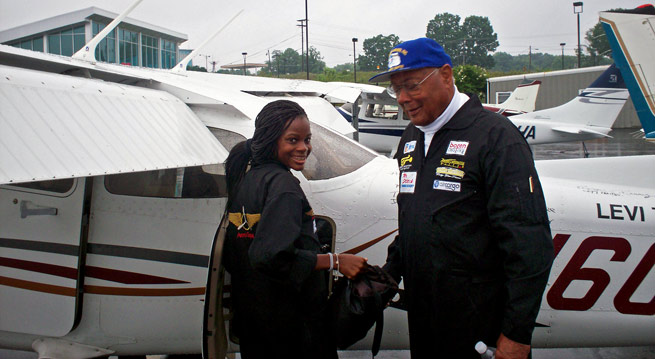
If 15-year-old Kimberly Anyadike had run into any trouble flying the Cessna 172 from Los Angeles to Newport News, Virginia, and back—the youngest African-American pilot to make the trip—she carried along the perfect instructor pilot in the seat behind her. That would be veteran Air Force pilot Levi Thornhill, with about 3,000 hours in his logbook, plus innumerable hours prior to that as an Air Force mechanic. Anyadike got her training at Tomorrow’s Aeronautical Museum (TAM), an organization at South L.A.’s Compton-Woodley Airport that teaches local, at-risk kids how to fly.
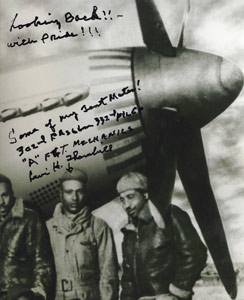 On the other hand, Thornhill, 91, learned all of his courtesy of the U.S. military several decades ago. “I’d gone out [to TAM] because I’m interested in flying, and whatever,” he says. “This girl was training there as one of the young pilots, and so Petgrave [Robin Petgrave, founder and chief pilot of Celebrity Helicopters, who started and runs TAM] came up with the idea to make this cross-country to promote her and the program.” Petgrave supplied a Cessna 172 and Thornhill went along in back, while another instructor pilot flew in the right seat. “She had the job of flying and navigating the airplane,” he says, “and we talked a lot before and after each leg.”
On the other hand, Thornhill, 91, learned all of his courtesy of the U.S. military several decades ago. “I’d gone out [to TAM] because I’m interested in flying, and whatever,” he says. “This girl was training there as one of the young pilots, and so Petgrave [Robin Petgrave, founder and chief pilot of Celebrity Helicopters, who started and runs TAM] came up with the idea to make this cross-country to promote her and the program.” Petgrave supplied a Cessna 172 and Thornhill went along in back, while another instructor pilot flew in the right seat. “She had the job of flying and navigating the airplane,” he says, “and we talked a lot before and after each leg.”
Thornhill’s advice is worth paying full attention to. He joined the Army Air Forces in 1942 and was shipped to Tuskegee, Alabama, for basic training; to Nebraska for aircraft mechanics school; and then to Italy as a P–47 crew chief for the 337th Fighter Group—aka the Red Tails, aka the Tuskegee Airmen. After the war, Thornhill stayed in the service, getting his private certificate in light taildraggers courtesy of the GI Bill. The Air Force accepted him for pilot training, and after graduating as a second lieutenant at Nellis Air Force Base in 1950, he received deployment orders for Munich—where he flew P–47s. He transitioned to jet fighters: F–86s, F–84s—all told about seven or eight different types—ending his career in T-33s and retiring as a major.
Of flying with Anyadike cross-country, he says, “It was quite a thrill. That young lady was unbelievable. I know she’ll go far in anything she decides to do. It was just a real, real joy for me, being around somebody like that.” Anyadike’s now in college studying medicine, while former Tuskegee Airman Thornhill keeps working with the South L.A. kids, talking about flying, and whatever.
AOPA Sweepstakes: AirMod cleanup
From grime to shine
By Thomas A. Horne
At this writing, interior shop Air Mod is smack dab in the middle of its renovation of the sweepstakes Debonair. The old interior is long gone, new seats have been fabricated (thanks very much to longtime sweeps contributor Garrett Leather, of Buffalo, New York), new side panels have been built, new floorboards created, and perhaps the biggest of the work package—locating and treating corrosion—draws to an end. Referring to corrosion treatment, Air Mod’s Dennis Wolter says that, “Of all the work we do here in restoring old airplanes, corrosion control is by far the most important.” Listen to him long enough and you hear a recital of horror stories: spars rotted through by mouse urine, wing skins corroded beyond repair by trapped moisture, salt air causing entire airframes to rot through. You get the idea.
Luckily, the Debonair hasn’t shown any untreatable corrosion. What has been detected has been very light—a true shock when you consider that this airplane is 50 years old. But there has been a lot of dirt. That’s bad, Wolter says, because dirt can hold corrosion-causing moisture. So a big part of the Debonair’s time at Air Mod has been spent cleaning up the dirt—a total of four pounds was found in the airplane’s belly—then treating the now-shiny aluminum with zinc chromate to inhibit any future corrosion. By the way, the dirt removal alone took 80 man-hours of painstaking labor.
Air Mod is performing other work. The Debonair has an overhead pushrod control that opens a fresh- air scoop on the airplane’s dorsal skin. The scoop’s air box had developed cracks that leaked air and also made operation of the pushrod difficult; now it’s fixed. A tail-mounted beacon/strobe assembly from Knots2U has been installed. And an Airwolf Filter Corporation remote-mounted spin-on oil filter has been installed. So yes, the aircraft is getting a new interior, but that’s not all that Air Mod is doing for the Debonair.
Those who have been following the Debonair’s oil-analysis saga—and there have been a lot of you—no doubt welcome the addition of the Airwolf filter. The original engine comes with a mere oil screen, so having a proper oil filter will help us do two things: Check the filter element for contaminants at oil changes; and hopefully aid in reducing the amount of metal particulates that have been showing up in the recent oil analyses. To see a more thorough discussion of the oil-analysis issue, as well as feedback from members, check the Sweepstakes Logbook blog (http://blog.aopa.org/sweepstakes_logbook/).
Believe it or not, folks, we’re nearing the end of the Debonair’s restoration. Yes, we’ll be keeping a close eye on any engine issues, but once the final paint scheme has been applied the job will be done! Then it will be time to show off the Debonair in its full glory. As always, stay tuned, and watch the blog for the latest developments.
Email [email protected]
Fly-Outs: Santa Rosa, California
Wine country has a strong aviation link
By Alton K. Marsh
Tourists think of Santa Rosa north of San Francisco as wine country, and that is correct. But it is also a great day trip for pilots, as photographer Chris Rose and I found out, even before we got off the Charles M. Schulz-Sonoma County Airport property. Just a two-minute drive from the terminal is the small but fascinating Pacific Coast Air Museum, one of two must-see discoveries we made. The first was the McDonnell Douglas (Boeing) F-15 fighter that led a flight of two in an effort to stop two airliners under control of terrorists that struck the World Trade Center. The jet was on the chopping block when the museum discovered it. The museum also has warbirds and spy planes. The second discovery was the chance meeting of Christina Olds, daughter of the late triple-ace fighter pilot Brigadier General Robin Olds, who helped assemble her father’s memorabilia into the book he meant to write, “Fighter Pilot: The Memoirs of Legendary Ace Robin Olds.” She is the museum’s operations director. Twelve minutes from the airport terminal building is a Smithsonian-like gem, the Charles M. “Sparky” Schulz Museum and Research Center. Headed by his widow, Jean Schulz, the museum includes the studio where Schulz created the “Peanuts” comic strip. You’ll learn how the strip was created. His son, Craig Schulz, said the actual drawings of characters came together not in an organized way, but were drawn from all directions at once (see “Pilots: Craig Schulz,” September 2013 AOPA Pilot).
The museum sits on a campus that includes a gift shop (schulzmuseum.org) and an ice arena the cartoonist built for the children of Santa Rosa. The arena includes the Warm Puppy Café where Schulz often ate breakfast and lunch.
Lunch at Kin in Windsor, California, north from the Santa Rosa airport was outstanding. It’s probably great for dinner, too, but for that we explored John Ash & Co. (above) south of the airport terminal. The food officially rated 4.5 stars out of five and will cost $60 to $70 for a meal. Chef Tom Schmidt spent 20 years learning his craft in Germany.
Email [email protected]
Charles M. Schulz-Sonoma
County Airport (STS)
Santa Rosa, California
707-565-7243
Rental cars: (www.aopa.org/cars)
866-315-9155
Fly-outs made possible by Enterprise Rent-A-Car
Supporting important work
Donations to the AOPA Foundation make it possible to support the important work of preserving the freedom to fly. There are thousands of organizations in the general aviation community participating in charitable efforts, including disaster response, medical relief flying, and transportation provided by volunteer pilots. The AOPA Foundation created the Giving Back Program and is proud to award grants to the following groups: Air Care Alliance, Lindrith, New Mexico; Challenge Air for Kids & Friends, Inc., Dallas; Duluth Aviation Institute, Duluth, Minnesota; Girls Inc. of Oak Ridge, Oak Ridge, Tennessee; Kentucky Institute for Aerospace Education, Frankfort, Kentucky; LightHawk, Lander, Wyoming; Pilots N Paws, Landrum, South Carolina; and the Recreational Aviation Foundation, Bozeman, Montana.
Flying boat captain drops anchor at 96
Last flight on his birthday
By Alton K. Marsh
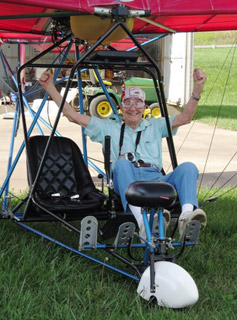 We all need to consider when it is time to hang up the headphones as we grow older. Lefty Leftwich considered his options carefully, nearly quitting in 2010, and decided to end his flying days on his birthday August 7 at 96 in a Quicksilver Sprint ultralight.
We all need to consider when it is time to hang up the headphones as we grow older. Lefty Leftwich considered his options carefully, nearly quitting in 2010, and decided to end his flying days on his birthday August 7 at 96 in a Quicksilver Sprint ultralight.
A.J. “Lefty” Leftwich flew admirals, State Department officials, and cargo to war in a four-radial-engine Boeing 314 flying boat from 1942 to 1945. He captained the first Douglas DC–6 for Pan American World Airways and was greeted by Berlin’s Lord Mayor Wily Brandt. He left airline service in the jet age as captain of a Boeing 727.
“It is with great sadness that at age 96, I’ll pull up anchor from my World War II flying boat days and cast off into the ‘wild blue yonder.’ It’s been a 70-year aviation love affair, undimmed by the sands of time,” Leftwich said in an e-mail.
He was given the FAA’s Master Pilot Award and has spoken at gatherings of the Commemorative Air Force about his boat days. The photo shows his final landing of his career—a good one, no doubt.
His son, Bill Leftwich, who inspects aircraft for Gulfstream Aerospace, said his dad enjoyed the last flight. “He flew around for at least an hour, taking pictures with his right hand while holding the stick with his left. When he finally landed, taxied up to the hangar, and motioned me over, he said softly in my ear, ‘OK, you can take it back to Savannah with you, I’m done.’”
Email [email protected]
A lifetime of flying
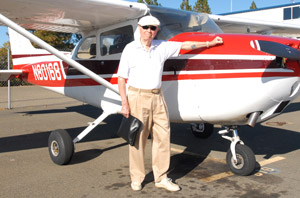 Lt. Col. Peter Weber Jr. retired Air Force, of Cameron Park, California, can claim more years of flying than most people have been alive. Born in Erie, Pennsylvania, in 1919, Weber fell in love with flying at 16 years old, took two lessons, but couldn’t afford to continue. He was making 20 cents an hour working at a gas station and flight lessons were five dollars a half hour. In 1942, Weber, then 23 years old and in the U.S. Army Air Forces, became an aviation cadet, launching his 30-year military flying career. His service spanned three conflicts: World War II, Korea, and Vietnam. Weber talks affectionately about the 34 military and civilian airplanes he’s flown, including the Lockheed P–38 Lightning, North American B–25 Mitchell, and the Lockheed C–130. “I’ve flown 19 different military airplanes, and my favorite is the P–38,” he said. “It was a pleasure to fly.”
Lt. Col. Peter Weber Jr. retired Air Force, of Cameron Park, California, can claim more years of flying than most people have been alive. Born in Erie, Pennsylvania, in 1919, Weber fell in love with flying at 16 years old, took two lessons, but couldn’t afford to continue. He was making 20 cents an hour working at a gas station and flight lessons were five dollars a half hour. In 1942, Weber, then 23 years old and in the U.S. Army Air Forces, became an aviation cadet, launching his 30-year military flying career. His service spanned three conflicts: World War II, Korea, and Vietnam. Weber talks affectionately about the 34 military and civilian airplanes he’s flown, including the Lockheed P–38 Lightning, North American B–25 Mitchell, and the Lockheed C–130. “I’ve flown 19 different military airplanes, and my favorite is the P–38,” he said. “It was a pleasure to fly.”
Weber now flies a Piper Archer, owned by his son Pete, and the Cessna 172 he rents and flies several times a month. He still flies solo and plans to celebrate his ninety-fourth birthday in the air this month. In 71 years of flying, Weber has logged approximately 8,500 hours. “I love everything about flying,” he says. —Geri Silveira
Ted the stowaway cat
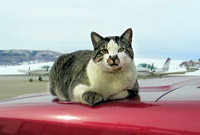 Ted stows away on departing aircraft. Some think it is just airport lore, but others know it is true. Do not doubt that Ted the Cat of Steamboat Springs/Bod Adams Field in Steamboat Springs, Colorado, is a stowaway. He will climb aboard your airplane and hide, revealing himself only in flight.
Ted stows away on departing aircraft. Some think it is just airport lore, but others know it is true. Do not doubt that Ted the Cat of Steamboat Springs/Bod Adams Field in Steamboat Springs, Colorado, is a stowaway. He will climb aboard your airplane and hide, revealing himself only in flight.
Ted is the airport security cat and is good at what he does; mice dare not lay claim to Steamboat Springs turf and sparrows are caught in mid-flight as they try to take off. There’s no escaping Ted. That said, everybody needs a little personal time off. Every day Ted watches humans fly off to exotic locations, and sometimes it just becomes too much to bear.
His best caper was a flight to New Mexico. When he came forward to greet the pilot in the cockpit at the halfway point, the pilot was too far into his flight to turn back. Ted ran up an $80 bill at an animal care center with room service before he was shipped home. Airport officials have pardoned him for that, and the other three times he did it. Now, Ted has a computer chip in him that provides his real identity.
Once a pilot reported he was returning to the airport to drop off a passenger. The pilot had just departed, so the call was puzzling. The aircraft taxied to a stop, a door opened, Ted was ejected, and the airplane departed again.
An airport official says that Ted, “nonchalantly” walks near an airplane he knows will soon depart. Then he disappears inside. He’s smart enough to avoid propellers—although he is down to eight lives. He slept under the tug once and was roughed up, but recovered by the time he reached the vet’s office. If he wasn’t so good with kids he would probably lose his job. —AKM
Email [email protected]
Co-pilot service dog
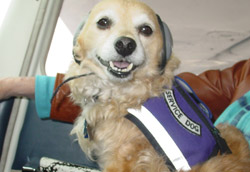 My wife Diana has a service dog named Gizmo. He is 12 pounds and picks up things for her. Gizmo accompanies us as we fly around Northern California in a Cessna 172 looking for our next $100 hamburger airport and, so far, he has logged 72 hours of flight time. He is very attentive during taxi, run-up, and climb-out, but falls asleep when we settle into cruise. He sleeps well with his Mutt Muffs and is secured to Diana’s shoulder harness.
My wife Diana has a service dog named Gizmo. He is 12 pounds and picks up things for her. Gizmo accompanies us as we fly around Northern California in a Cessna 172 looking for our next $100 hamburger airport and, so far, he has logged 72 hours of flight time. He is very attentive during taxi, run-up, and climb-out, but falls asleep when we settle into cruise. He sleeps well with his Mutt Muffs and is secured to Diana’s shoulder harness.
This spring, we were flying around San Francisco Bay considering lunch at Half Moon Bay (HAF), but I was concerned about fog. We decided to head north to Ukiah along Tomalas Bay. About midway up the bay, Gizmo sat up and began staring at the instrument panel with a very business-like face. He then looked at me, then back at the panel. Back and forth he looked for about 30 seconds when the engine began to sputter. I immediately knew what was happening—ice was forming in the carburetor. I applied carb heat and the engine returned to normal. Gizmo looked at me, relaxed his face, and went back to sleep.
I do not understand how he recognized the icing up of the carburetor considering the engine noise and his Mutt Muffs, but he did. All I know is now I have a co-pilot service dog.
—Submitted by Allen James, president of the PBY Catalina Foundation, Petaluma, California.
A duo of apps
Reviewing one new, one mature iPad application
By Ian J. Twombly
WingX
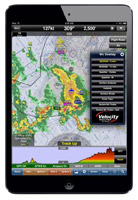 It’s been a few years since we’ve looked at WingX, and it’s clear the company has been very busy in the meantime. WingX remains toward the top of the popular all-in electronic flight bag application list, with good reason. It’s a solid, innovative application that does everything you could want and a whole lot more.
It’s been a few years since we’ve looked at WingX, and it’s clear the company has been very busy in the meantime. WingX remains toward the top of the popular all-in electronic flight bag application list, with good reason. It’s a solid, innovative application that does everything you could want and a whole lot more.
WingX is on version 7.1 as I write this. Given the features race in iPad applications, there likely will be an update by the time you’re reading it. Regardless, it’s easy to recommend WingX if for no other reason than it remains one of the easiest applications to use. Although I’ve been told that because of its menu-based home screen WingX doesn’t necessarily follow the Apple-decreed design philosophy, it’s a key differentiator and unquestionably a positive feature. It makes the application easy to use immediately after starting up, and without referencing a manual.
The big update in version 7 is a partnership with Baron Weather Services for overlay weather on the ground. Instead of importing static weather from DUAT or DUATS, the user can now import Baron’s extensive suite of weather products, including many with motion. With this the application becomes a much better flight planning tool. One of WingX’s core business philosophies has been partnerships with everything from traffic providers to secondary screens. Although confusing at times, it does lead to some real gems like Baron’s weather products.
Also included in the update is more seamless approach chart integration that now lays the course line and a breadcrumb trail on an approach chart.
WingX remains one of the best mapping and flight planning applications available, and is certainly worth a new look.
Price: $99.99 a year, plus additional fees for certain features
Contact: www.hiltonsoftware.com; Apple App Store
Jeppesen Mobile FliteDeck VFR
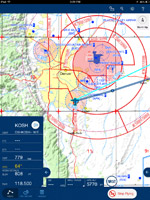 The biggest surprise in Jeppesen’s Mobile FlightDeck VFR may be that it’s from Jeppesen, a company not exactly known for being quick or responsive to market demands. But credit where it is due, because Jeppesen has absolutely nailed it with its newest iPad offering.
The biggest surprise in Jeppesen’s Mobile FlightDeck VFR may be that it’s from Jeppesen, a company not exactly known for being quick or responsive to market demands. But credit where it is due, because Jeppesen has absolutely nailed it with its newest iPad offering.
The trend in mapping and flight planning iPad applications has long been to cram as many features as possible into one application and then sell that same application to all pilots, regardless of the type of flying they do. Jeppesen is the first to acknowledge the fact that not every pilot has an instrument rating, and even many of those who do don’t use it regularly. Mobile FliteDeck VFR is a delightfully restrained application based on the company’s VFR + GPS charts. These were a great product at the wrong time, but with Mobile FliteDeck VFR the company has figured out a way to use the basic design of the charts in a more modern format.
The application gives VFR pilots exactly what they need—charting, preflight weather, basic flight planning, and airport data—and nothing they don’t. The charts aren’t scanned versions of the FAA’s sectionals, but rather Jeppesen’s own VFR-optimized digital charts that are considerably easier to use. Best of all, the application is database driven. This may sound insignificant, but how many times have you sat there waiting for a chart to load on an iPad application? That’s because the files are massive. It also means zooming is limited to the digital equivalent of a magnifying glass. With Mobile FliteDeck VFR, the charts load almost instantly and when you zoom in on an airport, for example, the whole presentation changes to one that’s optimized for that situation. There’s no more switching between airport diagrams and maps.
Mobile FliteDeck VFR is a superb application that every VFR pilot should consider, and I’d venture to say most IFR pilots would use it often as well.
Price: $49 a year
Contact: www.jeppesen.com; Apple App Store
Flight Training award winners named
Recognized at AOPA Summit
AOPA selected 12 top flight training professionals and 11 flight schools as winners in its annual Flight Training Awards. The top winner in each category was announced at AOPA Aviation Summit 2013 in Fort Worth, Texas. The top winners are Conor Dancy of Aviation Adventures in Manassas, Virginia, for Top Flight Instructor, and the San Carlos Flight Center in San Carlos, California, as Top Flight School (owner Dan Dyer).
The awards were selected from 3,375 respondents who voluntarily reviewed their flight training experience through an AOPA online poll. The process yielded an evaluation of 508 different flight schools and 956 individual flight instructors.
“It was clear from the customer reviews that every one of these schools and instructors are operating at an outstanding level of quality and service,” said Shannon Yeager, vice president of AOPA’s Center to Advance the Pilot Community.
To select the award winners, AOPA invited those who have taken flight training within the last 24 months to complete the Flight Training Excellence Poll. Each participant could nominate no more than one flight school and one flight instructor.
The online poll was conducted from April 10 to August 9, in a process that contains several safeguards to ensure fair competition. It consisted of 39 survey questions designed to measure the overall performance of a flight school or flight instructor through the customer’s eyes. The results were scored and averaged. Four questions that required free response answers were scored by AOPA employee-panelists who were unaware of the identity of the school or instructor.
AOPA also released an honor roll of 87 flight schools and 69 flight instructors, all of which demonstrated a high standard of accomplishment by achieving an average score of 70 percent or more.
Flight Schools
Aviation Adventures Manassas Regional Airport, Manassas, Virginia
Panorama Flight Services Inc. Westchester County Airport, White Plains, New York
Rochester AviationSkyhaven Airport, Rochester, New Hampshire
Riverside Flight AcademyRiverside Municipal Airport, Riverside, California
San Carlos Flight CenterSan Carlos Airport, San Carlos, California
Sporty’s Flight Center Clermont County Airport, Batavia, Ohio
Summit Aviation, Inc. Bozeman Yellowstone International Airport, Bozeman, Montana
The Flight School, Inc.Weiser Air Park, Cypress, Texas
Valley Aviation, Wilkes-Barre Wyoming Valley Airport, Wilkes-Barre, Pennsylvania
Western Air Flight Academy Rocky Mountain Metropolitan Airport, Broomfield, Colorado
Worcester Regional Flight Academy Worcester Regional Airport, Worcester, Massachusetts
Flight Instructors
Dileep Anne Front Range Airport, Watkins, Colorado
Conor DancyLeesburg Executive Airport, Virginia
Ray de Haan Leesburg Executive Airport, Virginia
Kelby Ferwerda Skyhaven Airport, Rochester, New Hampshire
Eric Florence Warrenton-Fauquier Airport, Virginia
Christopher Freeze Metropolitan Oakland International Airport, Oakland, California
Michael Gilbert Leesburg Executive Airport, Virginia
Bob HeppManassas Regional Airport, Virginia
Randall Holliday Bozeman Yellowstone International Airport, Bozeman, Montana
Robert Keleti Republic Airport, East Farmingdale, New York
Buchanan Smith Leesburg Executive Airport, Virginia
Brent Tuchler Manassas Regional Airport, Virginia
